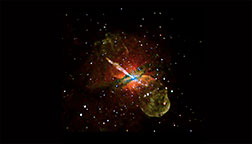- Number 441 |
- June 15, 2015
Antimatter is a blast

The Centaurus A galaxy, at a distance of
about 12 million light years from Earth,
contains a gargantuan jet blasting away
from a central supermassive black hole.
In this image, red, green and blue show low,
medium and high-energy X-rays.
Photo courtesy NASA/CXC/U.
Birmingham/M. Burke et al.
Using ever more energetic lasers, DOE's Lawrence Livermore researchers have produced a record high number of electron-positron pairs, opening exciting opportunities to study extreme astrophysical processes, such as black holes and gamma-ray bursts.
By performing experiments using three laser systems — Titan at Lawrence Livermore, Omega-EP at the Laboratory for Laser Energetics and Orion at Atomic Weapons Establishment (AWE) in the United Kingdom — LLNL physicist Hui Chen and her colleagues created nearly a trillion positrons (also known as antimatter particles). In previous experiments at the Titan laser in 2008, Chen’s team had created billions of positrons.
Gamma-ray bursts are explosions lasting no more than a few minutes but release more energy than the sun will emit in its lifetime.
Re-creating the birth of a gamma-ray burst isn't possible with current technology, but Chen and colleague Frederico Fiuza, a staff scientist at SLAC National Accelerator Laboratory, say new laser facilities coming online in the next few years will have that capability. These facilities could create beams of particles, which, when collided, would create high-energy gamma-rays via the same process that occurs in stellar explosions, black hole mergers and other extreme environments in nature.
"These are some of the most energetic events in the universe so we would like to understand what exactly happens there," said Fiuza said.[Anne Stark, 925.422.9799,
stark8@llnl.gov]
